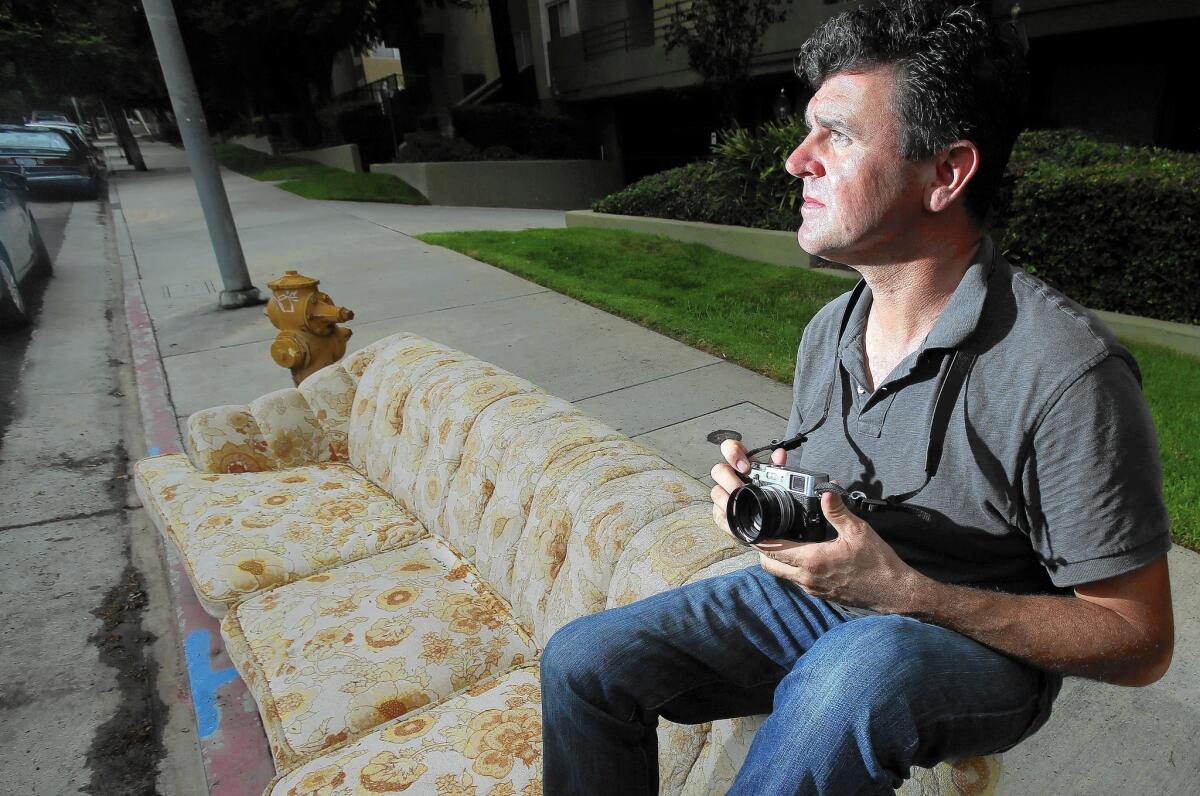Portraits of discarded sofas capture flotsam and jetsam of L.A.

- Share via
Why do the people of Los Angeles toss their couches to the curb? Andrew Ward can’t say for sure. But once he started noticing the castoffs, he couldn’t stop. They seemed to be everywhere.
Plush couches. Flowery couches. Austere, antique ones with high backs and carved wood frames. He spotted them plunked down in the street, left beside trash bins and blocking sidewalks, frayed and stained, cushions missing or torn or askew.
“You know how in the movie ‘The Sixth Sense’ the kid sees dead people? Well, I see sofas,” said Ward, who was born in Dublin, Ireland, where sofa dumping is, to the best of his knowledge, exceedingly uncommon if not completely unheard of.
For reasons he can’t entirely explain, Ward started snapping street sofa shots on his cellphone a few years ago. As he did, he began to ponder the transient nature of this city — so many people coming and going, constantly acquiring, constantly shedding.
One day he walked out to his car, parked at a friend’s house in North Hollywood, and found a worn armchair sitting alongside it. It had great springs and fine bones. He hauled it to his garage and then to an upholsterer, who jokingly referred to it as road kill.
The born-again chair and a formerly down-and-out street couch now grace his Highland Park living room.
Ward, 43, makes his living as a first assistant director for movies and TV. The projects, he said, are all-consuming, and even the smallest ones involve many, many people. Photography has long been an outlet that in its solitary, spare nature offers him balance.
Earlier in life, he would travel with his Leica, taking black-and-white portraits of strangers. He photographed monks in Phnom Penh, sugar cane workers in Cuba, children in a bare-bones school in Haiti.
In Los Angeles, as the couches called to him, he would pull over to record them for posterity. He began to see that these were portraits too — each with a particular personality, something about them surprisingly poignant. He bought a digital camera with a 35mm lens to try to do his subjects justice.
These pieces of furniture had been central to people’s lives. People had stretched out on them. They’d watched TV on them. They’d worked hard all day and then come home to sink their weary limbs into them. Some had clearly been lovingly chosen, for their bold prints, their sensuous curves. Some had probably been passed down. They had stories to tell, as did the abandoned mattresses that in recent months Ward also began photographing.
Now he frames each image in a specific way — sofa or mattress stage center, taken from a distance of about 20 feet. In the background are telling glimpses of the city: graffiti, a clipped hedge, the edge of a low stone wall.
He posts them on social media (#sofasofla), where an audience has been building.
To this day, Ward has never seen anyone in the act of dumping a sofa or mattress. But he knows many dumping hot spots.
His children, who are 4 and 6, roll their eyes when they’re in the car with him and he hits the brakes and pulls to the curb. His wife tolerates his project but pleads, please go ahead and click but do not touch. After Ward has his shot, he uses a phone app called My LA 311 to report the furniture to the city for pickup.
Los Angeles’ flotsam and jetsam fascinates him. Stray shopping carts. Fallen palm fronds. Lately Ward has been photographing a building that taggers love to hit. The city comes in and paints over, often not quite matching colors. He likes the geometric patterns that form.
As for the portraits of couches and mattresses, he hopes one day to publish collections of them. The sofa one, for the record, won’t be a giant coffee-table book. It will be more like the size of a small throw pillow.
Follow City Beat @latimescitybeat on Twitter and at Los Angeles Times City Beat on Facebook.
More to Read
Sign up for Essential California
The most important California stories and recommendations in your inbox every morning.
You may occasionally receive promotional content from the Los Angeles Times.











